|
The
origin of the Aibo should not be reduced to the design and
development of a prototype and a consumer product. The ideas
and technologies incorporated and inherent in a product
like an Aibo come from many and varied sources, developed
over time.
Creation
complex — the desire to create
The creation complex is common to all cultures. Whether
it is a story or an object, the goal is to create something
from inanimate matter that gives the illusion of autonomy
(independence) and life. Examples of the creation complex
can be seen in mythology, fiction, puppetry, automata and
robots.
Mythology
Pygmalion
| |
In
Greek legend, a brash young sculptor named Pygmalion
found the women of Cyprus so impossibly flawed that
he resolved to carve a statue of his ideal woman,
embodying every feminine grace and virtue. For months
he laboured with all his prodigious skill (and also
with a strange compulsion), rounding here, smoothing
there, until he had fashioned the most exquisite figure
ever conceived by art. So exquisite indeed was his
creation that Pygmalion fell passionately in love
with the statue, and he could be seen in his studio
kissing its marble lips, fingering its marble hands,
dressing and grooming the figure as if caring for
a doll. But soon, and in spite of the work's incomparable
loveliness, Pygmalion was desperately unhappy, for
the lifeless statue could not respond to his desires,
the cold stone could not return the warmth of his
love. He had set out to shape his perfect woman, but
had succeeded only in creating his own frustration
and despair.
(Excerpt from The
Pygmalion Project, by Dr. Stephen Montgomery )
Copyright
© 1989 Stephen Montgomery
|
Golem
The Golem
legend dates back to the early centuries AD.
| |
In
Jewish legend, a golem is an image or form that is given
life through a magical formula. A golem frequently took
the form of a robot or automaton. In the Hebrew Bible
(see Psalms 139:16) and in the Talmud, the term refers
to an unformed substance. Its present meaning developed
during the Middle Ages, when legends arose of wise men
who could instil life in effigies by the use of a charm.
The creatures were sometimes believed to offer special
protection to Jews. The best known of the golem stories
concerned a Rabbi Löw of 16th-century Prague, who
was said to have created a golem that he used as his
servant.
(From: Entry on 'Golem' in Microsoft Encarta 97 Encyclopedia
Deluxe Edition, c. 1993-1996 Microsoft Corporation,
Disc 1.) |
Fiction
Frankenstein
In Mary Shelley's novel Frankenstein,
Dr Frankenstein sets out to create human life from a lifeless
form. The Doctor collects bits and pieces — arms, legs,
a torso, a head — puts them together and brings his
creation to life. Instead of helping this newly created
life, Dr Frankenstein runs in horror from his lab and abandons
the creature. The creature is understandably angered by
Dr Frankenstein's lack of responsibility and wreaks revenge
upon his tortured creator.
|
Pinocchio
The
Italian author Carlo Lorenzini began writing
the
story of Pinocchio in 1881. Pinocchio is the name
of the central character. He first appears in the
story as a piece of wood selected by a carpenter.
The carpenter then creates life from this inanimate
material.
"How
it happened that Maestro Cherry, carpenter, found
a piece of wood that wept and laughed like a child
… "
|
 |
Frankenstein
and Pinocchio contrast different reactions from their creators.
One runs away from responsibility, the other cares and nurtures
his creation. This highlights the need to examine and discuss
moral and ethical responsibility
in the development of new forms.
Puppetry
The ideas presented by mythology and fiction cross over
to performance. This can be seen in the simplest hand puppet,
where the force that drives the puppet is concealed, to
examples of more complex puppets with articulated limbs.
Puppetry is popular in many cultures.
European
puppets were made to imitate human movements as precisely
as possible, whereas the Japanese counterparts, probably
influenced by Japanese traditional Noh plays, pursued
abstract movements to explain human emotions. The differences
between the two races, Japanese and European, are keenly
felt here. (Takanashi, 2000: 2)
Activity
Take time out to examine some puppetry
resources. Remember that this is a case study about an Aibo,
so look for relevant links and issues of design and use.
Resources
on puppetry
Automata
An examination of automata (pronounced or - to - ma - ta)
reveals the mechanical and technological inventions and
developments that are direct precursors to the robotic technologies
incorporated in an Aibo.
An
automaton is a device, usually in the shape of a human or
other animal, which appears to move independently of human
control. Throughout history, automata have been controlled
and powered by various means, for example:
- pneumatic
- hydraulic
- clockwork
and electro-mechanical mechanisms.
It
has been argued that the technologies developed and used
in automata were instrumental in the development of new
technologies throughout western technological history.
Observe
The Powerhouse Museum has an interesting collection of automata.
Here are a few from the collection.
This website has been archived and is no longer updated.The content featured is no longer current and is being made available to the general public for research and historical information purposes only.
|
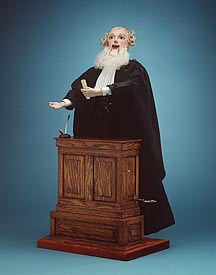
|
L'avocat
A
program of cams and gears controls this musical automaton,
which was made in France about 1900.
L'avocat (the lawyer) runs on a clockwork mechanism.
When set in motion L'avocat waves his right arm up
and down, turning his head from left to right while
his mouth opens and closes as if he is addressing
an audience. It is very comical.
|

Bird
automata
The mechanism of this automata is visible. The automata
is powered by clockwork. The slotted wheels control
the movement of the bird which swings back and forth
and opens and closes its beak. The
automata is also musical. The bird's beak movements
are synchronised with the tweeting sounds also generated
mechanically. |
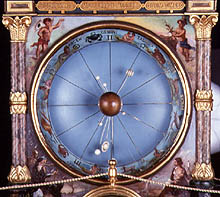
The
orrery of the 'Strasburg' clock model |
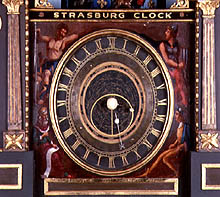
The
grand astronomical clock dial |
|
Pneumatic
and hydraulic mechanisms
The earliest control mechanisms harnessed gravity
by using sand or water to meter out a constant
force. These pneumatic and hydraulic devices were
used mainly in building but were also used in
the earliest forms of automata. These early automata
were exhibitions of power or magic — a door
would seemingly open of its own accord or a statue
would speak. |
|
|
|
Hero's
self-regulating mechanism
|
Clock
mechanisms
The technologies used in the measurement of time have also
played a key role in automata. Early clocks harnessed gravity
mechanically to drive an indicator at a constant speed just
as they drove some of the automata described above. With
the advent of the escapement mechanism (modern clockwork
mechanism), automata reached new levels of sophistication
and complexity.
Jacques
Vaulconson (1709-1782) created some remarkable automata.
You can see images of the remains of Vaulconson's duck,
which quacked, flapped its wings, drank, ate and excreted.
Although
some of these automata appear primitive in comparison with
contemporary robotic technologies, the audiences of the
day were as dazzled by them as we are today by the performances
of the Aibo.
http://www.nyu.edu/pages/linguistics/courses/v610051/gelmanr/ling.html
Electro-mechanical
mechanisms
Although there were still makers of automata in the 20th
century (including music boxes, organs and sideshow vending
machines) it is robots that have captured the imagination
of the public. Electro-mechanical mechanisms can use relays,
solenoids and electric motors. These mechanisms can be controlled
by valves, solid state and microprocessors.
From
the late 1950s developments in electronics produced smaller,
more reliable and faster control devices. The reduction
in the size and cost of these essential parts has contributed
to rapid developments in robotic technologies over the last
fifty years.
Robots
When you think of a robot what do you imagine? Many people
will visualise a human-shaped machine. The popular perception
of what a robot looks like is influenced by science fiction.
The human shape of many early robots from science fiction
films was based on the need to have an actor inside a costume.
This
idea continues even today with more contemporary representations
of what a robot looks like, for example, the robots in Star
Wars, Lost in Space, Forbidden Planet, Terminator, Robocop.
In
the real world, robots are not shaped like humans. Their
shape is dictated by their function.
Take
a tour of some web sites featuring robots:
http://www.robotics.com/robomenu/
http://www.robotmag.com/magazine/issue3.html
http://robotics.arc.nasa.gov/
http://www.robocup.org/games/98paris/3129.html
http://www.cs.cmu.edu/~minerva/
Activity
There are still people keen to 'create life' or to design
a lifelike robot or android. The following site takes a
close look at androids. Visit www.androidworld.com.
Once at the home page, take a look at World's greatest
android projects. Back to home and visit Smaller
android projects, select Robot Maxamilian which
takes you to www.howtoandroid.com.
Select How to build R. Max for clear instructions
and great photos.
Robots
in industry
The word robot comes from the Czech word robotnik
meaning 'work' or 'serf'. Robots are often used to accomplish:
- tasks
that are dangerous or impossible for a person
- tasks
that require intricate and precise actions, with no room
for error.
Manufacturing
industries were among the first to make extensive use of
robots. Most of the world's robots are found in factories
and other processing facilities. By the mid-1970s automated
production lines were beginning to turn out cars. Today
robots can be found in many industries, usually in the form
of manipulator arms or as 'intelligent' tools. Robotic systems
can make, move and store products and materials.
Observe
Take a look at some robots from the Powerhouse Museum's
exhibition, Cyberworlds. They are all shaped to help
them do their jobs in the most efficient way.
 |
| Spider
robot climbs up buildings or inside pipes. |
|
This website has been archived and is no longer updated.The content featured is no longer current and is being made available to the general public for research and historical information purposes only.
|
| Military
bomb-disposal robot, which looks like a tank.
|
This website has been archived and is no longer updated.The content featured is no longer current and is being made available to the general public for research and historical information purposes only.
|
Machines
in uniform: military and security robots
Robots are expendable and ideal for hazardous military and
security tasks. They are used by military forces, police
and security agencies. Autonomous vehicles fitted with sensors
or weapons can be used on the battlefield or for surveillance.
Robotics is expected to play a major role in future warfare
and for other military aims.
Activity
Develop your own design for a robot or animatronic. Make
sure you identify clearly the tasks you want it to do.
Cooperative
robots
An Aibo has applications apart from those of an entertainment
robot. Aibos were lent to institutions around the world
interested in the development of robotic applications. At
the 1999 RoboCup an informal league of teams, each equipped
with three Aibos, competed in an exhibition series.
The
UNSW
Robocup team came second in this competition.
Robotic
soccer represents a challenging environment in which multiple
robots work together to achieve objectives in the presence
of adversaries. Problem solving in this environment requires
that the robots learn from experience and feedback. To achieve
this, the Carnegie Mellon Trio (CMTrio) built in learning,
navigation, localisation and role-based behaviour capabilities
that allowed them to operate as team-mates on a small soccer
field. (Veloso et al, 1998)
| Images
from robocup |
|
This website has been archived and is no longer updated.The content featured is no longer current and is being made available to the general public for research and historical information purposes only.
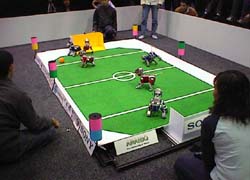 |
|
Photo:
Mike Lawther
|
|
This website has been archived and is no longer updated.The content featured is no longer current and is being made available to the general public for research and historical information purposes only.
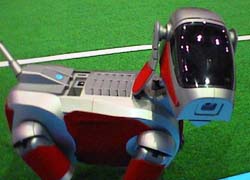 |
|
Photo:
Mike Lawther
|
|
This website has been archived and is no longer updated.The content featured is no longer current and is being made available to the general public for research and historical information purposes only.
 |
|
Photo:
Fiona Ho
|
|
This website has been archived and is no longer updated.The content featured is no longer current and is being made available to the general public for research and historical information purposes only.
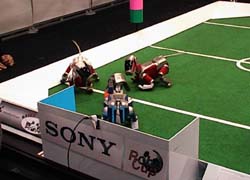 |
|
Photo:
Fiona Ho
|
|
Activity
Brainstorm potential uses of cooperative multiple autonomous
robots.
|